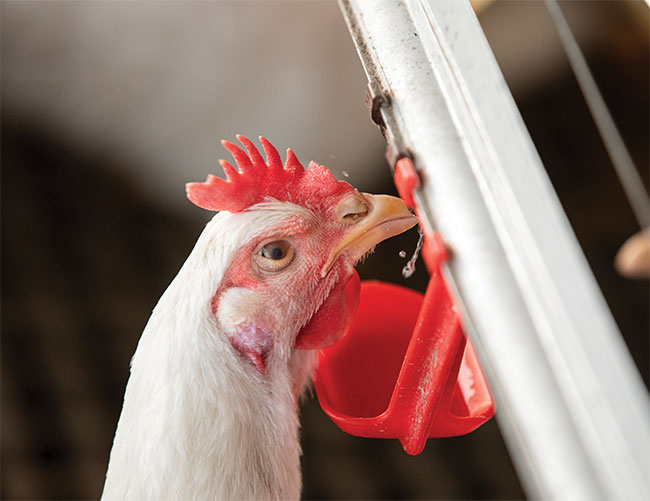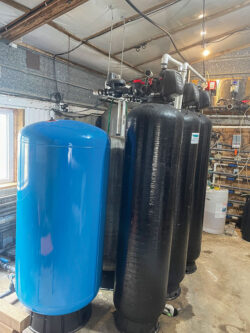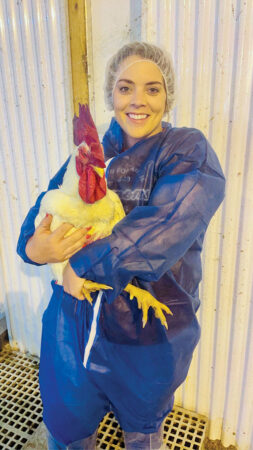
Uncovering the secrets of water quality
By Ronda Payne
Features Barn ManagementHow three farmers go the extra mile to ensure the health and purity of water for their flocks.
 Water is a critical yet often underappreciated part of poultry production, producers say.
Photo Credit: Alltech
Water is a critical yet often underappreciated part of poultry production, producers say.
Photo Credit: Alltech Water. It’s a vital necessity for all forms of life, including livestock. While humans consist of around 60 per cent H2O, chickens surpass that with a composition of 70 per cent water.
Even a slight decrease of 10 per cent in the essential fluid can prove fatal for a chicken. Therefore, it is crucial to deeply contemplate the significance of water in maintaining the health of birds.
Here, three producers who are well aware of the significance of water as a crucial input in their operations discuss the measures they take to ensure the purity, cleanliness, and healthiness of water for their birds.
Growing great tom turkeys in Ontario
Producing about 65,000 tom turkeys for consumer meat consumption, Steve Clark and his son Todd know more than a thing or two about the elements that lead to great quality birds. Steve and his wife Kim purchased their farm in Embro, Ont., in 1997 and now take a slightly less active role as Todd and his wife Cassandra are running the business.
The family run operation works seven cycles of about 9,500 birds each per year, from one-day-old poults through to finish at about 16 weeks.
“Water, feed and good air movement in the barns are key to growing good quality turkeys,” says Steve. “Bad water can stunt a turkey’s growth and cause certain ailments that will affect the farm’s bottom line. Keep in mind, we have been growing RWA (raised without antibiotics) for the last seven years approximately, so making sure everything is of great quality is extra important, as we cannot medicate if a problem arises.”
About four years ago, the farm switched to using an organic acid, called MS Goldmix, to reach the desired pH. This combined with Dutrion tablets that mix with water to achieve chlorine dioxide. The switch wasn’t a proactive one, but instead a response to some rather undesirable build up.
Slime that spreads
“In the late 90s and into the 2000s, water on the farm was good,” Steve says. “We could run your typical low doses of chlorine for pH along with low doses of peroxide to keep the waterlines free of biofilm. This achieved good water for the turkeys to drink.”
Then, about 10 years ago, something in the water table changed. There was a greater build up of slime and gunk in the filters. Of all the glamourous jobs in farming, cleaning and changing slimy filters more regularly and being concerned about the water isn’t a highlight.
“Eventually, it escalated to where our drinkers were gumming up with sliming biofilm and greatly reducing waterflow,” he says. “We tried numerous different acid products and sanitizers to try and solve the problem but kept hitting dead ends.”
In a stroke of luck, they found advice from a veterinarian who encouraged them to try an organic acid with chlorine dioxide.
“The chlorine dioxide keeps the waterlines clean and free of biofilm buildup,” he says., “And since we started using the products, our filters need to only be cleaned once annually and our waterlines and water cups have never plugged up.”
The need for feed
It takes very little for water pH to go sideways and wreak havoc with turkey growth.
“A good pH is vital to a turkey’s health,” Steve notes. “Although farmers’ opinions vary on what is a proper pH to achieve, we like to have our pH in the brood barn just below a five. The lower the pH, the harder it is for E. coli and harmful bacteria to live in the turkey.”
The flip side, however, is that if pH is too low, the birds may stop drinking and subsequently stop eating. This would decrease bird growth and impact profitability.
Todd says since making the switch to organic acid and chlorine dioxide, the birds are achieving target weights more consistently. Flock mortality levels are also improved.
“When there are fewer water disruptions… I’d definitely say things are much better productivity-wise than before,” he says.
Steve says a big selling feature is that there is no restriction on water flow with this system and the chlorine dioxide is tasteless and odorless – a huge improvement over traditional chlorine.
“However, these products aren’t cheap,” he notes. “We spend at least $20,000 a year. A similar-sized farm would probably spend at least 40 per cent less than us with other cheaper products.”
Implementation was simple and the pumps for the products work great. The chlorine dioxide pump sometimes has crystallization build up and needs to be cleaned, but Steve says this is a quick, 10-minute job to get everything back in business.

The Clark family are seeing big improvements in their turkey flocks since they started treating their water with organic acid and chlorine dioxide.
Many sites, many solutions
In Gentry, Ark., Samantha Beitia is the quality assurance manager of live production of broilers for Simmons Foods. Through several contract farms, the operation processes about four million birds a week.
“One thing I love most about my position is that I work with water quality,” she says. “There isn’t a one-size-fits-all program, so understanding the needs at each farm is important.”
She explains that water is the number one nutrient birds consume. More than feed. She refers to a study that says for every pound of feed a bird eats, they will drink 1.7 pounds of water.
Beitia understands that flock performance often improves when water is right and considers the challenges of various minerals and specifics to a farm’s water source.
Enhancing the system
“The first thing I’m going to do is I’m going to take a sample from the source, the control rooms and at the end of the line,” she says. “I’m going to look for bacterial contamination and I’m going to see what that looks like at each stage of the sampling. Also, a mineral analysis, as it’s typically a well, to see if there are any underlying problems.”
These tests help determine if there is a mineral issue, microbial issue, or both. She also makes use of a water camera to look at the line for visual factors.
“For Simmons, I’d say 90 per cent of our farms pull from a well and then we require storage tanks for animal welfare purposes,” she explains. “Typically, the well water goes through the storage tanks, through the underground lines and into the water control room. From the water room, we go through an inline filter, then you’re going into the house for the birds to consume.”
The inline filter is the “tell” in the system. Beitia uses visual observation to adjust as needed.
“If we didn’t have that filter, I wouldn’t know,” she says. “It could be a slime bloom. If you watch your filters, it could be your first line of defense. You know you need to get something in the water.”
She says problems can crop up quickly without warning. Her starting point is flushing the lines with fresh water to move the concerns out, then follow with a sanitation chemical to counteract the slime or other contaminants.
“Our water systems are vulnerable,” she says. “They can be a challenge to our birds. Our systems can harbour bacteria that can harm our birds.”
While she feels getting to optimal water quality is relatively simple, she is also aware that some farms have more significant challenges.

Samantha Beitia, who oversees quality assurance across multiple broiler farms for Simmons Foods, uses cameras to monitor waterlines.
The quest for the Holy Grail
Jordan Fois, farmer with Fois Poultry Farm in Wellenport, Ont., says he thinks all farmers and businesspeople look for the edge that advances them.
“I always thought water was the Holy Grail. It took me about four years to find the right person,” Fois says. “His name is Walter.”
Fois connected with Walter Bauer of Bauer Energy Design about 15 years ago to help with his broiler farm and he can’t say enough good things about how the water has improved since that time. In fact, it’s so good, he doesn’t think much about his water anymore.
In Fois’ large cistern, one of Bauer’s mixers slices through the water to “change the molecular structure,” Fois says. From there, the water is chlorinated in contact tanks for about 30 minutes, then runs through two green sand filters, a UV
system and then one last filter before making its way to the holding tanks.
“But it leaves all the minerals in the water,” he clarifies. “UV lights, I change once a year. I had one break down. After 10 years, I had to change a constant pressure pump. The system has been bulletproof.”
He told Canadian Poultry that he’d found the key to healthier water with this system in an interview about four-and-a-half years ago. Is it still just as good?
Absolutely.
“I don’t believe I would change anything,” he says. “I believe the benefits outweigh the costs when you have an ROI of less than five years. There’s hardly any ammonia in the barn, though, that’s not very scientific.”
He adds that the other benefit is that there is a great reduction in antibiotic need in the flock as well as with baby chicks. With five crops a year on a 10-week cycle, and about 200,000 kilos a quarter, the results speak for themselves.
He’s adamant about not just good, but great, quality water.
“We use this water to drink and to shower in as well,” he says. “My family comes first, the chickens come second. I collect water off the roofs of the barns and I also truck a lot of water in that comes from Lake Ontario.”
He doesn’t test his water much anymore. He walks into his water room and knows what to look for.
“You’re always looking for that edge and the edge for me was putting that system in,” he says. “Not only for me and my family’s health, but also for my bottom line. I think in North America in general we take water for granted. I think we should take a real hard look at water and the benefits of clean water. It’s so important.”
Print this page